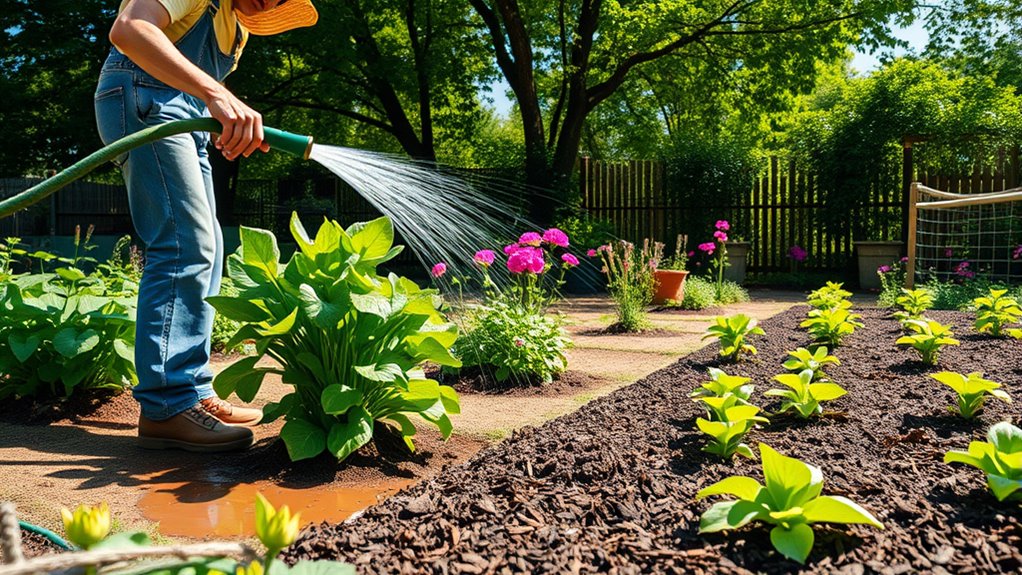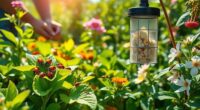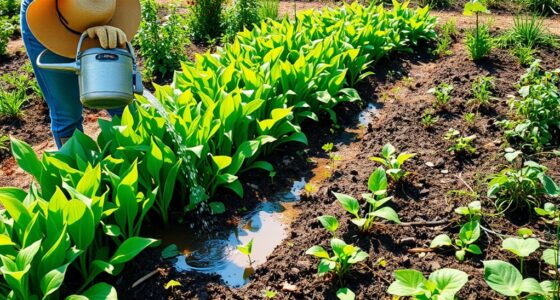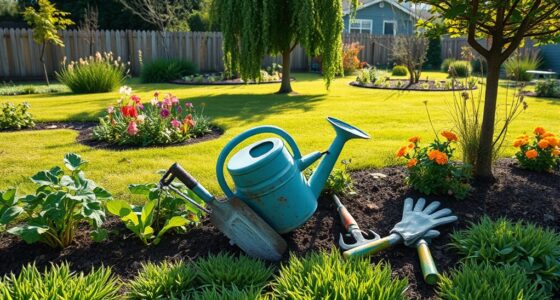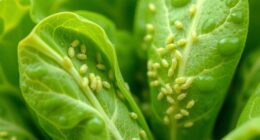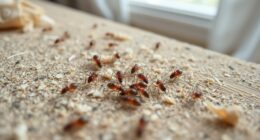To avoid common gardening mistakes, start with proper soil preparation by removing weeds, breaking up compacted areas, and adding organic matter. Choose plants suited to your climate, sunlight, and soil conditions, rather than just appearance. Plan your garden layout carefully, considering plant growth habits and spacing for airflow. Keep up with regular watering, health checks, and adjustments as plants grow. If you keep these tips in mind, you’ll set yourself up for gardening success. There’s more to discover that can help you thrive.
Key Takeaways
- Prepare and test soil quality before planting to ensure optimal growing conditions.
- Choose plants suited to your local climate, sunlight, and soil conditions for better survival.
- Plan garden layout carefully, considering plant size, growth habits, and sunlight needs.
- Maintain consistent watering, weed control, and regular health checks to support plant growth.
- Avoid rushing into planting; research and follow best practices for a healthier, more productive garden.
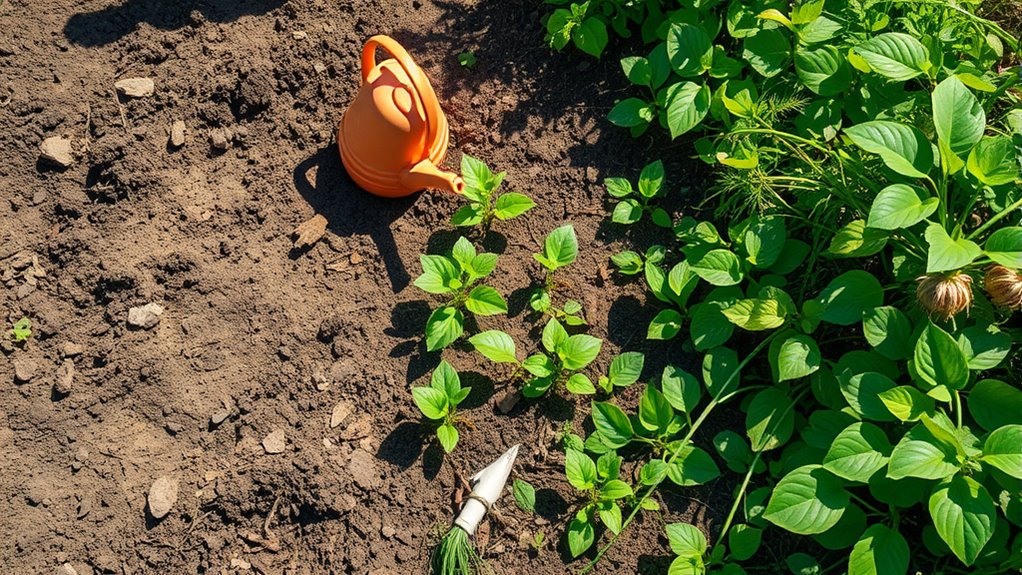
Starting your gardening journey can be exciting, but beginners often make simple mistakes that hinder their success. One of the most common errors is neglecting proper soil preparation before planting. Your soil is the foundation of healthy plants, so skipping this step can lead to weak growth or even plant failure. Instead of rushing to plant as soon as you get your seeds or seedlings, take the time to evaluate your soil. Break up compacted areas, remove weeds, and incorporate organic matter like compost or aged manure. This improves soil structure, drainage, and nutrient availability, giving your plants a much better chance to thrive. Without adequate soil prep, even the most carefully chosen plants may struggle to grow strong and healthy.
Proper soil prep is essential for healthy, thriving plants and a successful garden.
Another mistake many beginners make is choosing the wrong plants for their garden conditions. Plant selection is vital because not all plants are suitable for every climate, soil type, or sunlight exposure. Before planting, do some research to understand what will grow well in your area. Consider factors like sunlight hours, temperature ranges, and moisture levels. Picking plants that are adapted to your environment saves you from frustration and constant maintenance. It’s tempting to plant what looks attractive or what friends recommend, but if those plants aren’t suited to your conditions, you’ll spend more time and effort trying to keep them alive. Instead, select hardy, easy-to-grow varieties that match your garden’s specific characteristics.
Many beginners also overlook the importance of planning their garden layout. Proper plant selection isn’t just about choosing the right species but also about placing them correctly. For example, taller plants should go at the back of beds or in the center if you’re working with containers, while shorter plants go in front. This ensures good air circulation, prevents overcrowding, and makes maintenance easier. Overcrowding can lead to poor airflow, increased disease risk, and difficulty accessing plants for watering or harvesting. By planning your layout with growth habits and sunlight needs in mind, you set yourself up for a smoother gardening experience and healthier plants.
Finally, don’t forget that patience and observation are key. Even with the perfect soil and plant choices, your garden will require ongoing care and adjustments. Regularly check your plants for signs of stress or pests, water consistently, and adjust your practices as needed. Starting with good soil prep and thoughtful plant selection lays the groundwork for a successful garden, but your ongoing attention will keep it thriving. Avoid rushing into planting without these considerations, and you’ll enjoy a more rewarding and less frustrating gardening experience from the beginning. Remember that understanding your local climate and best gardening practices can greatly improve your gardening success.
Frequently Asked Questions
How Often Should I Water New Plants?
You should water new plants regularly to establish a consistent watering schedule that guarantees proper plant hydration. Typically, aim to water deeply every 2-3 days, but adjust based on weather and soil conditions. Keep the soil moist but not soggy, and check the top inch for dryness before watering again. Proper watering helps your plants develop strong roots and thrive in their new environment.
What’s the Best Soil Type for Beginner Gardeners?
For beginner gardeners, the best soil type is well-draining loamy soil. You should start with soil amendments like compost to boost nutrients and improve texture. Conduct pH testing to guarantee your soil’s pH is between 6.0 and 7.0, ideal for most plants. This way, you create a balanced environment that promotes healthy growth, making gardening more successful and enjoyable from the start.
How Do I Prevent Pests Without Chemicals?
To prevent pests without chemicals, you can use natural pest control methods like encouraging beneficial insects such as ladybugs and lacewings. Companion planting also helps; planting marigolds near vegetables deters pests naturally. Regularly check your plants for signs of trouble, remove pests by hand, and keep your garden healthy with proper watering and spacing. These techniques create a balanced ecosystem, reducing pest problems without relying on chemicals.
When Is the Ideal Time to Plant Different Vegetables?
You should plant vegetables based on seasonal planting guidelines and frost dates. Check your area’s last spring frost date and first fall frost date to determine the ideal planting window. Cool-season crops like lettuce and peas go in early, while warm-season veggies like tomatoes and peppers are best planted after the danger of frost passes. Timing your planting ensures your vegetables thrive and yield a healthy harvest.
How Can I Improve Soil Drainage Naturally?
They say, “A well-prepared garden is half the harvest.” To improve soil drainage naturally, you should add organic amendments like compost or aged manure to enhance structure. Incorporate organic mulching around plants to prevent compacting and promote aeration. These steps help water flow freely, prevent root rot, and create a healthier environment for your garden to thrive. Consistently maintaining this balance leads to better plant growth and a more productive garden.
Conclusion
Remember, gardening is like tending a delicate garden of your own. Every mistake is a weed you can pull out and learn from, helping your garden grow stronger and more beautiful over time. Don’t get discouraged by setbacks; they’re just part of the process. With patience and care, you’ll nurture your green space into a thriving oasis. Keep your enthusiasm rooted, and watch your garden flourish beyond what you ever imagined.
